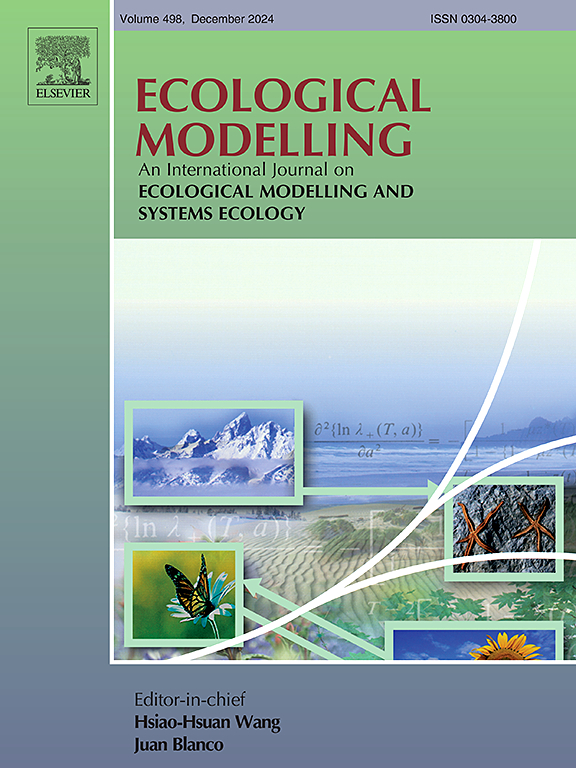黑潮-沽潮延伸区生态系统结构与营养动力学研究
IF 3.2
3区 环境科学与生态学
Q2 ECOLOGY
引用次数: 0
摘要
西北太平洋(NWP)不仅是世界上渔业产量最高的地区,而且是黑潮-亲潮延伸(KOE)的所在地。定期监测和评估海洋生态系统对于维持其稳定性和渔业产品的可持续性至关重要。基于2023年公海渔业资源调查数据,利用Ecopath与Ecosim模型对该海域开放海洋生态系统的营养结构和特征进行了分析。根据生态特征,共确定了25个官能团。利用野外采样信息作为生物量数据,最大限度地提高模型的质量。结果表明,各组的营养等级在1.00 ~ 4.35之间。鲐鱼是西北太平洋的主要经济物种,其生态营养效率低于以往的研究结果(2019年为0.74),表明其产量对生态系统能量的贡献比例可能有所下降。混合营养影响结果表明,各官能团之间的相互作用主要是捕食和取食竞争。总初级生产量/总呼吸量(TPP/TR)和总初级生产量/总生物量(TPP/TB)反映了系统的成熟度。与以往研究结果(系统总吞吐量为3529.54 t·km-2·年-1,TR为486.42 t·km-2·年-1)相比,TST (1766.22 t·km-2·年-1)和TR (151.27 t·km-2·年-1)均较低,显示出KOE生态系统的低生产力特征。结合高TPP/TR(7.31)和低系统杂食性指数(0.20),这些总体生态系统特征表明,东江生态系统结构简单,易受外界活动干扰。敏感性分析表明,模型的主要输出参数对官能团生物量的变化高度敏感。本研究可为东海开阔海域生态系统渔业管理提供参考。本文章由计算机程序翻译,如有差异,请以英文原文为准。
Study in the ecosystem structure and trophodynamics in the Kuroshio-Oyashio Extension area
The Northwest Pacific (NWP) is not only the region with the highest fishery production in the world, but also the location of the Kuroshio-Oyashio Extension (KOE). Regular monitoring and assessment of marine ecosystem are essential for maintaining its stability and the sustainability of fishery products. Based on the survey data from the high-seas fishery resources survey in the KOE in 2023, the trophic structure and characteristics of open ocean ecosystem in this area were analyzed using the Ecopath with Ecosim model. A total of 25 functional groups were defined based on their ecological characteristics. The field sampling information was used as the biomass data to maximize the quality of the model. The results indicated that the trophic levels of these groups ranged from 1.00 to 4.35. Chub mackerel is a major economic species in the Northwest Pacific Ocean, and the ecotrophic efficiency of chub mackerel was lower than in previous studies (0.74 in 2019), indicating that the proportion of its production contributing to the ecosystem energy might have decreased. Mixed trophic impact results showed that the main interactions between functional groups are primarily predation and feeding competition. Total primary production/total respiration (TPP/TR), and total primary production/total biomass (TPP/TB) indicated the system maturity. Compared to previous studies in the KOE and its adjacent area ecosystems (the total system throughput was 3529.54 t·km-2·year-1 and the TR was 486.42 t·km-2·year-1), both the TST (1766.22 t·km-2·year-1) and the TR (151.27 t·km-2·year-1) were relatively lower, which revealed the low productivity characteristic of the KOE ecosystem. Combined with the high TPP/TR (7.31) and the low system omnivory index (0.20), these overall ecosystem characteristics suggested that the KOE ecosystem was structurally simple and vulnerable to disturbance from external activities. Sensitivity analysis indicated that the main output parameters of the model were highly sensitive to the changes in the biomass of the functional groups. This study provided a reference for ecosystem-based fisheries management in the open ocean waters of the KOE.
求助全文
通过发布文献求助,成功后即可免费获取论文全文。
去求助
来源期刊

Ecological Modelling
环境科学-生态学
CiteScore
5.60
自引率
6.50%
发文量
259
审稿时长
69 days
期刊介绍:
The journal is concerned with the use of mathematical models and systems analysis for the description of ecological processes and for the sustainable management of resources. Human activity and well-being are dependent on and integrated with the functioning of ecosystems and the services they provide. We aim to understand these basic ecosystem functions using mathematical and conceptual modelling, systems analysis, thermodynamics, computer simulations, and ecological theory. This leads to a preference for process-based models embedded in theory with explicit causative agents as opposed to strictly statistical or correlative descriptions. These modelling methods can be applied to a wide spectrum of issues ranging from basic ecology to human ecology to socio-ecological systems. The journal welcomes research articles, short communications, review articles, letters to the editor, book reviews, and other communications. The journal also supports the activities of the [International Society of Ecological Modelling (ISEM)](http://www.isemna.org/).
 求助内容:
求助内容: 应助结果提醒方式:
应助结果提醒方式:


